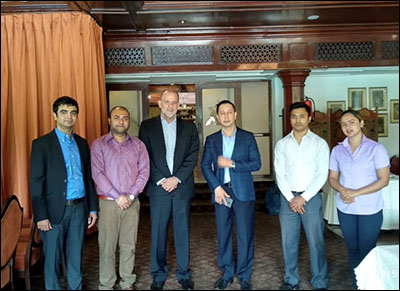
At the end of May, Digital Check took part in an educational event in Kathmandu, Nepal, to help bankers in that country figure out the right path for automating and expanding their branch networks. The financial system in Nepal has undergone a rapid transformation over the past several years, as roughly half the population has gained access to the formal banking system, compared with less than 10 percent a decade ago.
Nepal’s situation is part of a larger overall trend in Southeast Asia and the Indian subcontinent. Recent infrastructure improvements – especially in terms of Internet access for the general population – have given hundreds of millions of people the chance to own bank accounts for the first time. As a result, what used to be cash-only economies are quickly expanding into all other forms of payments. Our recent white paper on banking access in developing countries examines how this has changed the transaction landscape dramatically in recent years.
The net effect of this “banking land rush” is that many Nepalese financial institutions are attempting to build brick-and-mortar branch networks from the ground up, while striking a balance with rapidly growing online services. That means they’re also tasked with finding ways to reach Nepal’s “extreme” remote communities, which rank among some of the most isolated towns and villages in the world. More than 50 delegates representing 22 of the country’s largest banks came together to discuss these and other challenges at the two-day event.
This seminar also served as the launch of our ScanBox kiosk platform in Nepal, and for good reason: The kiosk has proven to be a popular way for banks in the region to inexpensively provide support for their expansion efforts. Neighboring India and Sri Lanka have installed thousands of kiosks for cheque deposit, billpay, and cash transactions all around the country, as financial institutions seek to add basic services to rural and semi-rural populations that number in the tens (or hundreds) of millions.
One of the big problems with kiosks, however, is that obtaining them can be a haphazard process. There’s no “standard” design, or even a universal plan for which functions deserve their own standalone machine, or should be combined in a single device. So, a lot of kiosks in this part of the world are built to order – and banks have to evaluate several kiosk manufacturers and integrators who do not have standard design, have different fabrication qualities, and use components from varied OEMs that is not consistent.
ScanBox, on the other hand, is a standardized product that reduces bank’s time to market and cost of acquisition – one of the major reasons why we developed it, and why it’s been gaining momentum in the India subcontinent, where kiosks are plentiful. (In this case, it also doesn’t hurt that the ScanBox is US-made, and provided by a manufacturer that already several thousand scanners already being used by every bank in Nepal.)

Beyond kiosks, Nepalese banks have also been considering remote deposit capture (RDC) as another tool for automation, as it also reduces the manual processes in the branch – as well as a way to reach isolated areas efficiently. RDC has not yet been formally adopted in Nepal (truncation of cheques is not allowed outside the branch), but signs are that a consensus may be possible to allow this one day as an important step toward modernization.
Another hot topic is ultraviolet (UV) scanning, which has been seriously considered as an anti-fraud tool. While not all Nepalese cheques currently use UV security features, the central bank’s official guidelines for cheque printing do include a designated place for them. Because of that, as well as the country’s smaller size and number of banks, it would probably be fairly simple to implement such a feature. As we discussed in our 2013 white paper on the subject, capturing an ultraviolet image allows much more in-depth security processes to be used, and for 100 percent of cheques to go through the more rigorous process; whereas the manual inspections in place elsewhere provide only cursory precautions on a fraction of deposits. We’ve already installed tens of thousands of UV cheque scanners in India and elsewhere around the world, and witnessed years of fraud reduction as a result.
We’ll be looking forward to bringing you more updates from Nepal in the future, as the path forward clarifies itself, and the actual RDC systems and branch buildouts start taking shape. A few banks left the meeting ready to start on their own pilot programs and proofs-of-concept, so we’re hopeful that we’ll get to see some new and uniquely Nepalese payments systems ready to take off soon!





